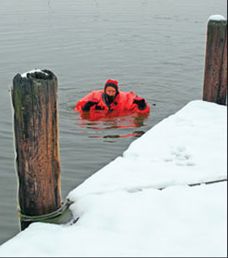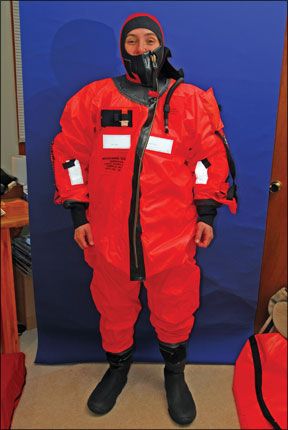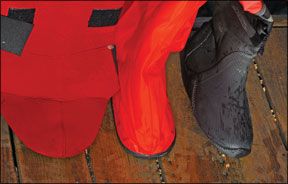Dominated by polyurethane-coated nylon immersion suits, the selection reflected a clear change in material preference among survival suit manufacturers. The tested immersion suits prices ranged from $260 to $700. Many of these companies also offer higher-grade, more expensive immersion suits that are aimed at commercial and search-and-rescue markets. Testers performed a thorough comparative analysis of the survival suits both in the water and on land. Details that were scrutinized included: weight, material, seam construction, zipper, reflective surface, boot and glove configuration, and air-purge valves. Testers were disappointed to find some of the suits used harnesses that could put sailors at risk.
****

As summer rolls around, high-latitude destinations like Alaska, Nova Scotia, and Newfoundland hold an irresistible draw for experienced cruisers. The Arctic high settles over the region, keeping wind speeds in check. Frontal passages are less frequent and mean sea heights dip. Although air temperatures reach comfortable levels during the day, water temperatures still pose a serious threat to mariners.
Hypothermia isn’t the only concern. Canadian researchers have found that immersion in water below 52 degrees can cause laryngeal and upper respiratory spasms that impede breathing and significantly raise the chance of drowning long before hypothermia sets in. This cold-water respiratory response, coupled with the potential hazard associated with hypothermia, explains why commercial fishermen, tug boat crews, and other professional mariners plying colder waters carry, carefully maintain, and practice using survival suits. These garments are well insulated “dry suits” that afford entry via a waterproof zippered front and effectively seal in heat while keeping water out. They are quick and easy to don and offer enough protection from the elements to increase the chances of surviving being in the water until rescue.
The standard for most immersion suits is to provide a minimum of a six-hour survival time in 32-36 degree water with no more than a 3.6 degree drop in core temperature. Individual differences in metabolic rate and body fat make such statistics a thick crayon mark rather than a number with pin-point accuracy. Even so, its clear that the better the insulation and the drier one remains, the longer the survival time, and combining an immersion suits insulation capacity with high-tech garments beneath will further improve suit performance.
Originally, survival suits were made from neoprene that was carefully stitched and glued in order to make the seams watertight. The design was a thicker version of a divers wet suit, but the principal of operation was very different. Instead of functioning as a conventional wet suit, trapping and warming a thin layer of water between the wearers skin and the neoprene, a survival suit keeps all the water out, and the suit itself, rather than a layer of body warmed water, acts as the insulation. The survival suits loose fit also sets it apart from a conventional wet suit. The baggy fit makes it easier to don, essential in any crisis situation.
What We Tested
We tested six suits from three manufacturers, Mustang Survival, Stearns and Viking. Dominated by polyurethane-coated nylon suits, the selection reflected a clear change in material preference among suit manufacturers. The tested suits prices ranged from $260 to $700. Many of these companies also offer higher-grade, more expensive suits that are aimed at commercial and search-and-rescue markets.
Four of the six suits we tested&emdash;the Mustang Ocean Commander (OC8001), the Stearns 1596 Dryflex, the Viking PS5002, and the Viking PS5006&emdash;were made of nylon material that had been calendared (sealed) with a polyurethane coating. This process produces a thin, tough, waterproof, and flexible outer skin with limited insulation quality. Linings are added to improve the heat retention. For insulation, the Stearns and the Mustang suits use a closed-cell foam liner, while Viking uses a quilt-backed nylon material (Meida) for insulation. The two traditional neoprene suits &emdash;Stearns 1590, in sizes small and adult universal&emdash;were stiffer and a bit more cumbersome, but proved to be easy to don and were warm and well sealed. However, the foam-lined, thin-skin suits like the Stearns 1596 and Mustangs Ocean Commander had a slight edge in overall rating from our evaluation team.
What We Found

All the tested survival suits have zippers, and it is important that these are regularly checked for corrosion and waxed or lubricated (see “Zipper Details”). In several instances, corroded zippers have made it impossible for crew members of sinking vessels to close their survival suits. All new suits come with written reminders about zipper maintenance and the dry storage of survival suits. These waterproof zippers are hard to zip up and down. More than 20 pounds of tension was required to zip up all of the tested suits but one. The Viking suits, which have smooth-sliding zippers with heavy duty seals, needed just 10 pounds of pull. Oxidized zippers can significantly increase these numbers.
A downside to survival suits is that the heavy gloves and the one-size-fits-all nature of the suits and sole pads inhibit dexterity (see “Glove and Mittens Examined”).
Feet were less affected, especially in the two suits we tested that had rigid, boot-like bottoms with built-in neoprene liners. The Stearns 1596 and Mustang Ocean Commander suits took top honors in the boot category with the Stearns 1590s simple neoprene foot design a distant second.
“Universal” was the size stamped on most of the suits we tested, and this “one-size-fits-all” survival suit size range seemed a little too optimistic and raised some questions. Two of the Stearns suits and the Mustang products were defined as “Universal” in size and appropriate for those from 5 feet to 6 feet, 6 inches and from 110 to 330 pounds in weight. At either of the extremes in this size range, issues such as head seal, boot size, and wrist seal would become an issue.
Our largest tester (
Practical SailorTechnical Editor Ralph Naranjo, 5 feet, 9 inches and 190 pounds) was unable to pull the Viking PS5002 sleeves over his forearms while wearing a polar fleece, and had to remove the fleece to get into the suit, giving up the extra insulation the garment offered. Its size rating was for individuals up to 6 feet, 6 inches and 330 pounds.
Our female tester (5 feet, 6 inches and 130 pounds) found the hood seal too loose on the Stearns 1590, which seemed designed for men with larger heads. She discovered that the loose seal allowed air to rush in and out as she bobbed on the surface. The effect caused loss of heat and the opportunity for water to replace the purged air if she were inundated by a breaking wave.
With each suit, individual body shape and size differences impacted effectiveness. A survival suit, like any wearable garment, should be tried on for fit before purchase. Pay careful attention to the face seal, zipper operation, and wrist seal (if gloves are removable).
Survival suits can make personal flotation devices (PFDs) difficult to wear. Some PFDs do not have enough adjustability in the chest to cope with the survival suits extra bulk, and those that are too constricting can be very uncomfortable once hydraulic pressure forces air up toward the torso. Most suits that qualify as a Type V PFD incorporate a foam or air bladder-type back pad that increases buoyancy when a victim is on his back. It also helps the victim roll over when a change in position is desired. A large Type I PFD would help float a victim even higher, improving visibility, and chance of rescue.
Modern, layered thermal insulating base layers are a best bet when it comes to what to wear prior to donning a survival suit. Mustang and other survival suit makers market thermal underwear for this purpose. You must remove shoes to don a suit, and most wont accommodate a heavy jacket. However, thermal socks and long underwear, along with fleece pants and a pullover usually fit, ensuring that this layering logic will pay off.
Mustang Ocean Commander
This Mustang suit is made from a polyurethane-coated fabric with seams that are heat-impulse welded rather than stitched. The gloves are full mittens, and the wrist seals seemed tight but worked quite well, even on our female testers thin wrists. The large volume wet-suit-style mitten was easy to put on, but the first slug of near-freezing water that entered was disconcerting. Once the water-filled mitten was warmed and hands were kept at or just above the surface, all worked well. One tester suggested that a different design of wet-suit glove might be preferable.
The closed-cell foam lining was similar to the Stearns 1596 liner, and all our testers preferred these foam liners over the Meida material used in the Viking suits. The material seemed to compress less and provide better insulation around the legs, which end up submerged deeper when the victim is in a vertical position, and, therefore, endure more pressure.
This suit, like the Stearns 1596, incorporated a rugged, attached pair of neoprene-lined rubber boots that provided both traction and good ankle support as well as afforded good thermal protection. Nylon web tabs located on the boots and near the wrist seals helped in donning the suit. Individuals with wide, size 12 or larger feet may have a problem with the boot and, as mentioned earlier, the time to discover problems with the fit of a survival suit is prior to purchase, not when youre launching the life raft. For the really big boys, theres a size called “oversize.”
Made in Canada, the Mustang suit was the only model tested that incorporated a well thought-out buddy tether with a wrist loop that answered the problem of how to disengage from a sinking boat or a delirious victim thats putting you at risk. A simple loop could be slipped from the wrist and a timely escape made.
Bottom Line:
This well-constructed suit fulfilled its primary mission by keeping our testers warm and dry. The wrist lanyard addresses an issue that plagues some of the other suits, and the boots serve well on deck. It is our Best Choice, slightly edging out the Stearns 1596 Dryflex Universal.
Stearns 1590 (small)

This is a classic U.S. Coast Guard approved, closed-cell neoprene survival suit that has been refined over the years and offers good buoyancy as well as thermal insulation. It is made in Thailand, and the workmanship is good. Packed in a vertically opening PVC bag, the suit is easy to access, directions are clear, and the donning process (like stepping into a pair of overalls) is straight forward. The suits thick neoprene skin provides the only insulation, and the absence of a liner makes it very easy to climb into. The closed-cell neoprene affords the best flotation, but is less flexible than the Stearns 1596, which is a polyurethane-coated nylon suit.
Working the YKK zipper required 14-24 pounds of pull, and closing a donned suit took significant effort. This zipper would greatly benefit from a T-handle puller like that found on the Mustang Ocean Commander. The suits 11 reflective tape swatches and bold, red color made it easy to spot, but not quite as daylight-visible as the “molten orange” color of some of the urethane-coated suits. With gloves and boots attached, it proved to be watertight and warm, however, the poor seal of the hood posed a significant concern to our smaller female tester. This suit came with neither a chest harness nor a fixed buddy tether, two features that can create more risk for the wearer (see “Tether Warning,”).
The suits stiffer nature made overhand and side stroke swimming more difficult, but an elementary backstroke proved easy and fairly efficient. The flotation and abrasion resistance of thick neoprene continues to be a plus even though lighter, more flexible PU-coated nylon suits are gaining market share.
Bottom Line:
This classic material and construction is stiffer than the coated-nylon suits, but its abrasion resistance, ease of donning, and long-term durability are nice pluses. Small individuals should check hood size carefully.
Stearns 1590 Universal
Though the same model number as the Stearns 1590, the “Universal” was both larger in size and offered a few different features. It also had a foam back pad and air bladder for additional flotation. The built-in harness was a mixed blessing (see “Tether Warning,”). Zipper-pull tension ranged from 18 to 22 pounds, requiring a hefty tug to close. This zipper would also greatly benefit from a T-handle zipper pull.
In the water, the hoods face seal was tight, keeping warm air in and cold seawater out. This was mainly due to the hood being the right size for the head of the person testing the suit. There was a little too much squeeze at the chin, but this made for a tight seal. The neoprene suit provided excellent warmth to the torso and extremities, and the built-in five-fingered gloves couldnt be beat for keeping the hands warm and dry. The attached ball-type whistle was loud and easy to use, definitely a better signaling device than the flat, low profile whistles most test suits were equipped with. (The loudest whistle in our last sound signals test, “Make Some Noise,” September 2006, was the Storm Safety Whistle by All-Weather Safety Whistle Co.
,www.stormwhistles.com.).
Bottom Line:
Although the zipper needs improvement, its clumsy on land, and the built-in harness raises some concern, the Stearns 1590 Universal kept testers dry and warm. Its affordable price, $260, makes it our Budget Buy.
Stearns 1596
Dryflex Universal

This polyurethane-coated, nylon survival suit from Stearns was completely different from the two 1590 series neoprene suits. Easy to step into, this flexible suit incorporated a thermal insulation barrier housed inside a waterproof outer skin of coated nylon. The closed-cell foam liner snaps into the coated nylon outer skin.
The new, coated-nylon immersion suits from both Mustang and Stearns use welded seam technology instead of stitching to join panels. Viking continues to use stitched and taped seams. This keeps the raw side of the nylon out, while Mustang and Stearns expose the sealed side of the nylon in order to weld seam joints, zipper installation, and other attachment points. Theres debate over which method is better, but both manufacturing techniques meet U.S. Coast Guard and Safety of Life at Sea (SOLAS) standards.
Donning the Stearns 1596, testers were initially skeptical of the large, heavy-duty boots, but they proved to be the preferred option when it came to warmth and surefootedness on deck. The thickly lined, supple, five-finger gloves also proved to be the most dexterous of the attached gloves. Nylon rub patches and knee patches protected the waterproofing in regions where abrasion was likely. Even so, some care must be taken with all PU survival suits to avoid sharp edges and hard abrasive contact while abandoning ship.
Bottom Line:
This was the best suit in terms of mobility and dexterity, well adapted for the duties involved in abandoning ship. It kept wearers dry and warm and was a good fit. Running almost neck and neck with the Mustang Ocean Commander, the Stearns 1596 earned the testers high recommendation.
Viking PS5002
Both Viking models are insulated with the SOLAS-approved Meida fabric liner, but the PS5002 it has twice the amount. The Meida offers high durability and high thermal insulation even when its compressed in water. The zipper is offset to one side, and this helped with the face seal in the chin area. The liner can be unzipped to the waist and is removable. A flat whistle and strobe are attached to the chest, and a buddy tether is hard-fastened to the suit, again raising the question of what happens when you want to release yourself from someone or something?
No leaks occurred with this suits seam stitching, and the wrist seals were tight on our male tester. The physiological differences between men and women underscore the need to try before you buy. Both Viking suits came with a harness that incorporated the questionable use of a carabiner clip and D-ring. The suits bright orange color and effective use of reflective tape made it highly visible&emdash;another essential rescue attribute.
Bottom Line:
The offset zipper is smooth and fast, and it provided an excellent, more comfortable seal at the face. Visibility is exceptional, but the Meida liner scored lower for warmth and ease of donning.
Viking PS5006 Universal
The storage bag used a plastic zipper (other manufacturers use snaps) that Viking says requires no maintenance. Wed routinely check it anyway.
The suit was light and flexible with a calendared-nylon, waterproof outer skin and a Meida thermal liner that zipped in place inside the suit. The fabric-lined suit was slightly more difficult to step into, but the suits lightness, flexibility, and compact size made it easy to stow. Both Viking suits came equipped with smooth sliding zippers, and they were stitched rather than built with welded-seam technology. A built-in buddy tether was sewn into the suits chest, and a single action carabiner clip/D-ring was used with the harness; once again,
Practical Sailorfeels this carabiner does not belong on either end of a safety tether.
Soles were sewn into the bottoms of the wide leg ends with only a Velcro ankle strap for support. The result was an awkward alternative to a boot. The sole had a good grip, but the poor support made walking feel like wearing sandals with no straps. Survival suits are primarily designed for the water, but the crew must be able to move about a pitching, heaving, and sinking vessel prior to abandoning ship, and the sloppy fit of the loose soles along with socks slipping on the inner nylon liner surface, seemed far from ideal.
At the hands, the removable mittens gave a crew additional dexterity and allowed for the last-minute operation of communications equipment and the ability to open locker latches and retrieve vital gear. Retaining fine motor skills right up until its time to hit the water can be critical.
In the water, the Viking PS5006 immersion suit proved to be quite flexible, allowing a victim to easily roll over and change floating position or swimming stroke. Like all of the suits tested, air was easy to purge and, by retaining the right volume, both flotation and warmth were enhanced. The fabric liner was moisture repellent, a trait that was unintentionally discovered due to a small leak in the suit we tested. The leak seemed to come from the seam stitching in the crotch area, and after 20 minutes in the water, the moisture had collected around the testers right foot. Some water also entered the suit via the left wrist.
Bottom Line:
Compactness and high visibility are big pluses, but this suit leaked at the stitching and the Meida liner made it more difficult to don. The unsupported boot design also leaves room for improvement.
Conclusion
All of these suits will prolong your life in cold water, some better than others, and the differences came down to the details. The Mustang Ocean Commander ($600) and the Stearns 1596 ($500) were our standout performers. The Mustang featured removable mittens and the Stearns came with toasty warm, permanently attached gloves. They both represent the new trend in nylon/polyurethane skin and foam liner technology, and each ended in deck-gripping boots that worked well in and out of the water. Not cheap, these suits reminded us that in many cases, you get what you pay for.
A close look at the price tag on one of the runners-up gave us a clear Budget Buy. The Stearns 1590 Universal suit is available at discount chandlery Hamilton Marine for $260. It offers excellent thermal protection and rugged, watertight construction at half the price of the winners. Its made of more bulky neoprene and is stiffer, but its easy to don and is a sensible alternative for those on a tight budget.


































